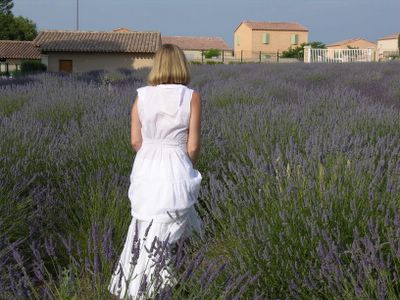Musée Provence

We left Aix Sunday afternoon for a drive north into Peter Mayles country, in search of lavender fields. We stayed in Le Clos des Lavandes, a Maison d’Hote near Lacoste. At the Musée de la Lavande in Coustellet, Darlene made a pretty sight surrounded by lavender in her white flowing skirt. Yesterday morning we explored the Luberon region of high Provence, visiting the ancient towns of Rousillon and Gordes before driving back to Aix for the train to Cannes.
I found Provence baffling. On the one hand, there is no denying the allure of the flowers, the low mountains, the fields of lavender and wheat, the historic towns built topsy-turvy on little outcrops of red stone, the colorful shutters of the buildings, the fresh salads, the rich chocolate cake, and the centuries of history and culture. On the other hand, it feels like Disneyland because of all the shuffling tourists, all of us walking at the same distracted, slow amble that we use in malls, museums, and amusement parks. It is the walk of people who don’t know where they are going and who have very little idea what they are seeing. I remember on St. John in the Virgin Islands, when I volunteered for a reporting job for the local newspaper, how suddenly I found myself walking at a different gait. I strode to an assignment purposefully, tacking through the shuffling tourists in their bathing suits and flip-flops, on my way to somewhere known and desired.
The contrast of these two views of Provence leads me to feel that the “real” Provence is somehow lost, that all that’s left is a huge outdoor museum or theme park. We drive from town to town the way we wander from room to room in the Musée D’Orsay. But this equates “real” mainly with the date. If one could plop oneself down in the middle of Rousillon two or three centuries ago, there would be no lost herd of tourists, no racks of postcards, nothing “fake.” There would also be few people alive over the age of 50. So being 54, I have no desire to live in the “true” Provence, or the “true” Colorado (before all those Easterners ruined it) or the “true” anywhere else, if “true” means everything being the way it was before the arrival of indoor plumbing.
These thoughts led me to the obvious conclusion that the “true” Provence was exactly what I found in Rousillon yesterday morning: beautiful old buildings in a lush countryside, a combination of landscape, history and culture which has attracted people from all over the world. And the real work of Rousillon today is not plowing fields and hauling rock, it’s setting the chairs out for lunch at a café, renovating an old building to create a new business, or figuring out how to expand parking discretely so more people can come and wander around, leaving a trail of Euros behind them.
My French friend Jean-Marie is very discouraged about his country in the wake of the Non vote on the European Constitution. He criticizes France’s slowness to change, to adopt new ideas and ways of handling the realities of the new millennium. He and Joyce, my friend from Harvard, plan to spend more and more time in Morocco. I have been struck by this same disillusionment in the French media these past three months. It’s another source of bafflement for me. Arriving here as an American innocent, seeing everything with amazed eyes, I feel sad that the French are going through such a despondent time.
As we drove our rented car through Provence, we listened to “Matador,” the newest CD by Mickey 3D, a young French group that sings of hopelessness, revolution, and love in music enlivened by Arab influences and rhythms. You can’t detect much hope for the future from their lyrics, but the music is, oddly, full of life and humor, just right for rolling past the lavender fields of Provence. If yesterday had been a short movie, Mickey 3D offered the perfect soundtrack. In this hugely popular group, the travails of France have given birth to a new and original music, recalling the way that American agonies gave birth to jazz and rap.
In Roussillon yesterday, I was taking photos of buildings when I noticed a beautiful young woman arranging herself and winking, as if she assumed I was talking a photo of her. Not a bad idea, I thought, so I walked over and asked if she would pose for a real portrait. Her friend urged her on, suggesting this might be a chance at Hollywood. Leslie, who was born in Metz and lives in Roussillon, loved this thought. I like to think her radiance could be taken as an image of hope for what the young will make of the mess they will inherit in France as well as everywhere else in the world. Leslie, who is 20 years old, does not appear to think she is living in a museum. Perhaps she is smiling at the thought of what she, herself, will make of the future of France.

